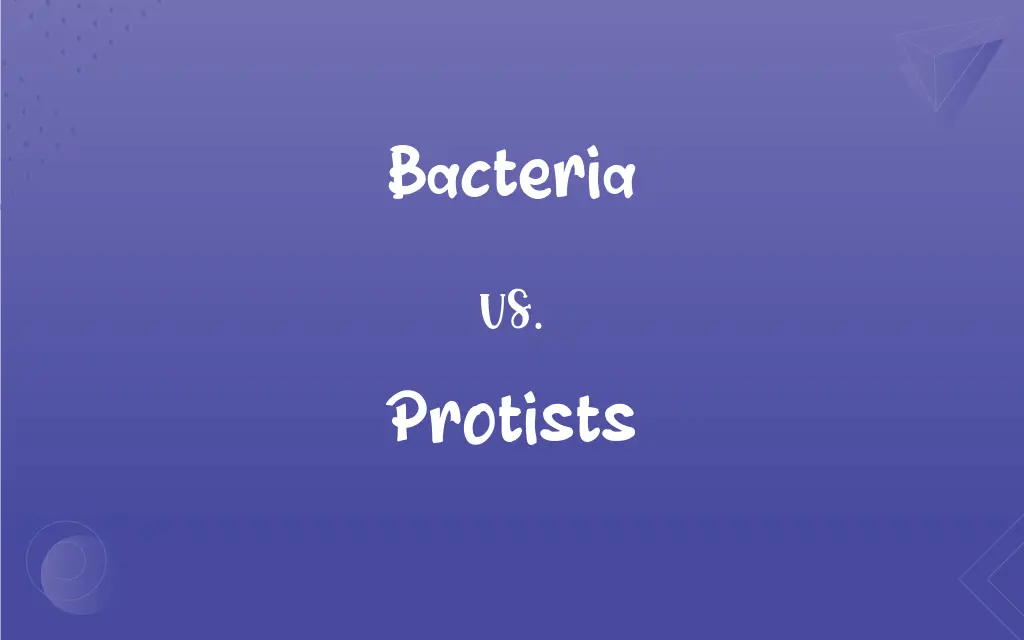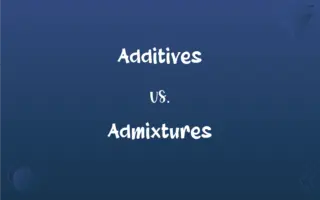Bacteria vs. Protists: What's the Difference?
Edited by Janet White || By Harlon Moss || Updated on October 19, 2023
Bacteria are single-celled prokaryotic organisms, while protists are diverse eukaryotic organisms, often single-celled.

Key Differences
Bacteria and protists represent two distinct groups of microscopic organisms. Bacteria, belonging to the domain Bacteria (and also Archaea), are prokaryotic, meaning they lack a nucleus and membrane-bound organelles. They are ubiquitous, found in various environments from soil to human guts.
Protists, on the other hand, belong to the domain Eukarya and are primarily single-celled, although some multicellular forms exist. Unlike bacteria, protists have a nucleus and other membrane-bound organelles. They form a diverse group and can be plant-like (algae), animal-like (protozoa), or fungus-like.
The metabolic capabilities of bacteria are diverse. They play crucial roles in processes like fermentation, nitrogen fixation, and decomposition. Many bacteria also have a relationship with hosts, ranging from mutualistic to pathogenic. Protists, with their varied nature, can be photosynthetic, predatory, or even parasitic.
Bacteria reproduce primarily through binary fission, a simple splitting into two. Some bacteria can also exchange genetic material through processes like conjugation. Protists exhibit a range of reproductive strategies, from binary fission to sexual reproduction involving complex life cycles.
When it comes to ecological significance, both bacteria and protists play vital roles. Bacteria help in recycling nutrients and can influence climate by acting as atmospheric particles. Protists, especially photosynthetic ones, contribute to the base of aquatic food chains and play roles in global carbon cycling.
ADVERTISEMENT
Comparison Chart
Cellular Organization
Prokaryotic (no nucleus)
Eukaryotic (with nucleus)
Kingdom/Domain
Bacteria (and Archaea for some types)
Eukarya
Reproduction
Mainly binary fission
Varies (binary fission, sexual reproduction, etc.)
Examples of Metabolism
Fermentation, nitrogen fixation
Photosynthesis, predation
Presence of Membrane Organelles
No
Yes
ADVERTISEMENT
Bacteria and Protists Definitions
Bacteria
Often characterized by their shape (rod, spherical, spiral).
Rod-shaped bacteria are called bacilli.
Protists
Can be photosynthetic, predatory, or parasitic.
Some protists, like algae, produce oxygen.
Bacteria
Reproduce primarily through binary fission.
Under optimal conditions, bacteria can divide rapidly.
Protists
Diverse group of eukaryotic microorganisms.
Protists are a fascinating study in diversity.
Bacteria
Single-celled prokaryotic organisms.
Bacteria can be found in a variety of environments.
Protists
Have a nucleus and membrane-bound organelles.
Unlike bacteria, protists have a more complex cell structure.
Bacteria
Microscopic entities lacking a nucleus.
Bacteria have a simpler cellular structure than eukaryotes.
Protists
Found predominantly in moist environments.
Protists thrive in aquatic habitats.
Bacteria
Can be beneficial, neutral, or harmful.
Some bacteria in our gut aid in digestion.
Protists
Often single-celled, but some multicellular forms exist.
Some protists can form colonies.
Bacteria
Plural of bacterium.
Protists
Any of numerous eukaryotic organisms that are not fungi, plants, or animals and are chiefly unicellular or colonial. Protists that are multicellular do not have cells differentiated into tissues. The protists include the protozoans, certain algae, oomycetes, and slime molds.
Bacteria
(US) A type, species, or strain of bacterium.
Protists
Plural of protist
FAQs
Are all bacteria harmful?
No, many bacteria are beneficial and essential for various processes like digestion.
What are protists commonly known for?
Protists are known for their diversity, ranging from algae to protozoa.
Can bacteria be seen with the naked eye?
Generally, no. Bacteria are microscopic and require a microscope to be observed.
Do protists have a cell wall?
Some protists, like algae, have cell walls, while others, like protozoa, do not.
How do protists reproduce?
Reproduction in protists can be asexual (like binary fission) or sexual.
What role do bacteria play in the environment?
Bacteria play essential roles in decomposition, nutrient cycling, and more.
What's the lifespan of bacteria?
It varies, but under optimal conditions, some bacteria can divide every 20 minutes.
How do protists move?
Protists use various structures for movement, including flagella, cilia, and pseudopodia.
Why are bacteria important in food?
Bacteria are crucial for fermenting foods like yogurt, cheese, and sauerkraut.
How can bacteria be classified?
Bacteria can be classified based on shape, staining properties, or genetic sequencing.
Where can protists be found?
Protists are predominantly found in aquatic and moist environments.
Are antibiotics effective against protists?
No, antibiotics target bacteria. Specific antiprotozoal drugs are needed for protist infections.
Are protists found in human bodies?
Yes, some protists live harmlessly in humans, while others can cause diseases.
Are protists plants or animals?
Protists are neither plants nor animals. They are a diverse group with plant-like, animal-like, and fungus-like members.
Do protists cause diseases?
Some protists are parasitic and can cause diseases, like malaria caused by Plasmodium.
How can bacteria be beneficial?
Bacteria aid in digestion, produce vitamins, and compete with harmful bacteria in our bodies.
Can bacteria survive extreme conditions?
Some bacteria, called extremophiles, thrive in extreme environments like hot springs.
Are bacteria and protists the same thing?
No, bacteria are prokaryotic, while protists are eukaryotic, representing two distinct groups.
How do bacteria reproduce?
Most bacteria reproduce through binary fission.
Are all protists microscopic?
While many are, some, especially some algae, are large enough to be seen without a microscope.
About Author
Written by
Harlon MossHarlon is a seasoned quality moderator and accomplished content writer for Difference Wiki. An alumnus of the prestigious University of California, he earned his degree in Computer Science. Leveraging his academic background, Harlon brings a meticulous and informed perspective to his work, ensuring content accuracy and excellence.
Edited by
Janet WhiteJanet White has been an esteemed writer and blogger for Difference Wiki. Holding a Master's degree in Science and Medical Journalism from the prestigious Boston University, she has consistently demonstrated her expertise and passion for her field. When she's not immersed in her work, Janet relishes her time exercising, delving into a good book, and cherishing moments with friends and family.
































































